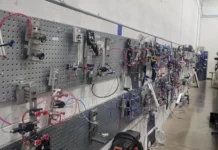by Tim Lewis
The concept of continuous improvement is well established and has proven invaluable for increasing consistency and efficiencies in manufacturing processes. However, few businesses have taken the opportunity to apply these principles to professional business practices even though the benefits are equally impressive.
Any business process that is repeated can benefit from the application of continuous improvement habits. One area of business where there is great opportunity to apply these principles is costing and quoting. Consistency, accuracy, timeliness, and efficiency are all vital to the preparation and submission of successful quotes.
Quotes are not only a necessary evil to gaining business, they can be a vital tool to help assess your business and job profitability. Done poorly and inefficiently, they can drain your resources and be an area of frustration. Let’s evaluate a few ways quotes impact your business:
- Quotes can be the yardstick by which you measure each job’s productivity. Conversely, the ability of manufacturing to meet or beat quoted costs should be used to modify your quoting standards and drive your manufacturing cost improvement efforts.
- Inefficient costing and quoting can be expensive. If an engineer making $60,000 per year prepares an average of 20 quotes per month at an average of 26 minutes per quote, costing and quoting costs you over $4,400 per year out-of-pocket.
- Inaccurate costing and quoting will result in lost sales if the quote is too high to be competitive and lost profits if the quote is too low.
- Quotes are part of your company’s image. Every time you send a customer a quote you are judged on timeliness, competitiveness, consistency, and professionalism.
- Many customers today require that you use their costing standards and, in some cases, completely different costing methodologies. Without periodic improvement efforts, how will you adapt your system to your customers’ demands?
Evaluation of the quoting process starts with the receipt of a customer’s request for quote and ends with your analysis of why you did or didn’t get the job. All of the steps along the way offer areas to scrutinize for improvement.
The steps in a typical quoting process, and areas to analyze for improvement are listed below.
Receive the Request for Quote (RFQ)
You need to know that when you receive an RFQ it will be handled in a standardized manner. Quotes that are not handled in a standardized manner are likely to end up lying around for days with no activity. Don’t lose work because you didn’t process a quote or you delivered the quote too late. Your system should begin with logging the RFQ and due date. Records that are not standardized and organized are difficult to find and use. This costs time and money. A written record on a standardized form kept in an easily accessed location is a good solution. A spreadsheet or database file on a central file server is easier to administer and offers opportunities for analyzing data from multiple quotes, based on common criteria.
Feasibility Review
Before devoting time to calculating a quote, you will want to have a procedure for reviewing each RFQ for feasibility. Keep a record of your conclusion and, if possible, have this document stored for access and review when necessary. The automotive industry uses a standardized Team Feasibility Commitment form for this purpose. This document spells out a standardized format for evaluating the feasibility of costing, quoting, and manufacturing a part, as well as providing a written record of the review. You can get a copy of this document from numerous sources online.
No Quotes
If the feasibility review shows the project to be “Not Feasible” for your company, you should “No Quote” the project. You will need to establish a procedure for “No Quotes.” Make sure your procedure communicates to the customer that you are not able to quote this part, but are still interested in quoting future parts. Communicate the reason for the “No Quote” if at all possible. You do not want to give the customer the impression that you are not interested in quoting future work.
Estimate Costs
Since this is the most complex and repetitive part of the process, there is ample opportunity to add efficiency and consistency here by applying continuous improvement practices. Every quote will require information and costing in at least some of the following areas:
- Equipment Set-up
- Raw Materials
- Equipment Operation
- Direct Labor
- Packaging
- Freight
- Tooling
You must ensure that the individual doing the cost estimate is using the latest cost data (machine rates, material costs, and labor costs). You also want to ensure your costing information is in line with your competitors. This key information should be kept in an easily accessible format, updated on a regular basis, and routinely compared to industry benchmarks. Sources for this benchmarking include MAPP, plastics industry publications, and your local chamber of commerce.
Plan a consistent way to perform routine calculations. When a sample part or part weight is not provided, you must calculate the part weight, area, or volume. Simple formulae for the volume of a rectangular solid are pretty easy to remember, but how about the formula for the volume of a hexagonal solid? Make this information easily available in order to minimize the time needed for calculations. Even so, doing this math with a calculator is tedious and subject to errors. Automating these calculations is preferable. Since this information will be used repeatedly and must be accurate and consistent, establish careful record-keeping and retrieval practices. Paper forms stored in a standard location can work but may be inefficient; spreadsheets or database files on a central server offer some distinct advantages for storage, updating, and retrieval.
Review and Approval
You may want to establish a requirement to have a second set of eyes review cost estimates before a quote is generated for a customer. A few minutes spent here can save your company big dollars and embarrassment. Decide who does the review and how it is documented. Make sure the information needed to do the review is easily accessible and in an easily understandable format.
Prepare the Quotation
Take a critical look at the actual quotation and the steps necessary to generate it. Perhaps the document can be automatically created from the data gathered. This saves time and eliminates one opportunity for errors. If a separate Quotation document is generated manually from the cost estimate, make sure it is checked. Review your standard format to see that it projects a professional image and includes the information requested by the customer.
Convey the Quotation to the Customer Follow-up and Feedback
Even though the process of quoting is officially done, do you have a system to track follow-up activity? Sometimes the buyer just needs to know you’re really interested in the project. This activity can determine who gets awarded a job when several vendors have quoted very similar pricing. Also, feedback from the prospective buyer is valuable information that can be used as benchmark data to fine-tune your costing.
Opportunities to Improve
There are many approaches to costing and quoting. A few molders may be using notebook paper and calculators; many are using computer spreadsheets. Others have stand-alone quoting programs or software integrated into their business systems. Any system can be critically reviewed, following your continuous improvement process.
As in many areas of manufacturing, technology can be a powerful tool to improve costing and quoting. Using a database approach can help automate and standardize quoting and tracking. Some advantages to this method may include the following:
- Standardized costs – Stored digitally, costs are captured, stored, and updated for access by multiple users, if kept on a central server. When the cost of a certain material or component changes, this adjustment only needs to be made one time even when it affects multiple parts.
- Automatic calculation – Area, volume, weight, and clamp tonnage are built-in, eliminating the need to look up or memorize formulae.
- Automatic data conversion – English or metric dimensions can be used without manual conversion.
- Multiple operation cost approaches – Costs are calculated automatically using hourly rate or per-shot cost, including cycle time and number of cavities.
- Pre-formatted common forms – Forms can include built-in Team Feasibility Commitment worksheets, quotations, and reports.
- Automatic quote generation – A presentation-ready quotation is created from costing data.
- Data integration for manufacturing planning – Reports on annual material usage, annual machine hours, annual labor hours, and more can be generated from costing data.
- Flexible retrieval of data – Save, find, and sort quotes based on multiple criteria for reports or reference.
- Easy adjustment of an existing quote – Duplicate an existing quote to re-quote, update costing data, or to quote a similar part.
- Built-in follow-up – Automatically track and report on follow-up activities for quotes.
A company’s commitment to continuous improvement can and should go deeper than the production floor. The basic philosophies behind process analysis lend themselves to many of the activities performed by office and professional staff, and may offer greater opportunities for savings.
Tim Lewis is the owner of Ampersand Design in Shelbyville, Ind. and a consultant in operations management. Lewis has over 35 years of experience in managing and setting up automotive injection molding plants. Ampersand Design developed and distributes Resolve-It, a complete problem-solving and tracking system, and PlasQuote, a costing and quoting system designed specifically for injection molding and assembly. For more information, call (317) 392-0163, e-mail amperdes@mac.com, or visit Ampersand Design’s web site at http://web.mac.com/amperdes.




